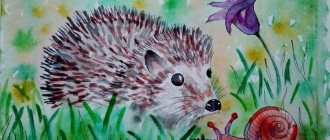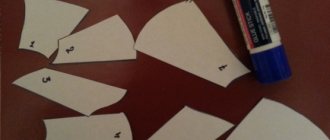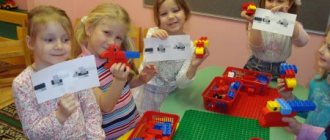Summary of the game-excursion “Enterprises of our region” in the preparatory group
Bibliographic description:
Solovyova, M. L. Summary of the game-excursion “Enterprises of our region” in the preparatory group / M. L. Solovyova. — Text: direct // Questions of preschool pedagogy. — 2021. — No. 6 (43). — P. 101-104. — URL: https://moluch.ru/th/1/archive/199/6443/ (access date: 12/29/2021).
Tasks:
- Introduce children to the concepts of goods, production, products (“Cognitive development”).
- Strengthen children's knowledge of the composition of numbers (“Cognitive development”).
- To consolidate children’s knowledge of the concepts “cheap” and “expensive” (“Cognitive development”).
- Develop the prerequisites for combinatorial skills (“Cognitive Development”).
- Strengthen the ability to solve circular examples and algorithms).
- Develop creative imagination and out-of-the-box thinking. (“Cognitive Development”).
- Strengthen ideas about professions. (“Cognitive Development”).
- To develop the ability to answer questions, developing dialogical speech in situational conversation, the ability to draw conclusions (“Speech development”).
- To develop children’s ability to interact with peers, to treat their peers’ answers kindly and respectfully (“Social and communicative development”).
Methods and techniques:
— practical: game situations, problem situations
— visual: demonstration pictures, handouts.
- verbal: questions, reasoning
Materials and equipment: subject pictures depicting production and goods, easels, a board, a cube with window inserts, felt machines, cards depicting an algorithm, cards with circular examples, cards with a code, boxes with planar geometric shapes.
| Children's activities | Forms and methods of organizing joint activities |
| Gaming | Games “Lay out the goods by price”, “Pick up the wheels”, “Pick up the instructions for the toy”, “Restore the program”, “How much in total?”, “Candy packers” |
| Communicative | Situational conversations, conversation. |
Progress of the lesson:
Educator. Guys, I want to share the news with you, a new Supermarket store has opened in our village.
Invites children to the board, which depicts store shelves.
Name the departments that you see in the store. Pay attention to the shop windows. What did you notice?
The children name the departments, but notice that all the display cases in the departments are empty.
— What’s missing from store windows? (Products).
— Where do you think the goods come from to the store?
“Today our task is to fill the shelves of display cases in different departments of the store with goods. And a magic cube will help us with this, with the help of which we will take a tour of various enterprises and production facilities in our region and find out what goods they can supply to our store.
The teacher leads the children to a cube on which pictures depicting the production of the “Bakery Factory” are placed in the windows.
Educator. - What kind of enterprise do you think we ended up in? (Bakery factory)
- How did you determine?
Children answer and make assumptions.
Game “Sort out the goods by price”
Educator. Help the bakers put baked goods on the shelves. Take one baked goods each. Look, every product has a price. Think and determine which shelf your product should be on. Bakery products that cost less than 10 rubles should be placed on the red shelf, and bakery products that cost more than 10 rubles should be placed on the green shelf.
Children take one card at a time, determine the price of the product and attach it to a specific shelf.
Educator. Well done boys! Bakers, in exchange for your labor, give you the products of their labor. In which department of the store should we place this product? Children place goods on the display of the bakery department in the “Supermarket”.
The teacher and the children approach the cube and open the following windows with the image of the “Machine-Building Plant” enterprise
Educator. Determine the name of the next production facility we will visit. What kind of products do you think are produced here? (Cars, parts for cars).
What professions do people work at the machine-building plant? (Fitter, electrician, mechanic)
Let's help the factory workers select wheels for their cars.
Game "Match the Wheels"
Educator. Take one car at a time. Each car has a number on it. You need to select the wheels so that the sum of the numbers on the wheels is equal to this number.
Children match wheels to cars and hang them on an easel, performing mutual checks.
Educator. You did great! In exchange for your work, you receive the plant's products. And we continue our excursion.
Children place goods on the correct display in the “Supermarket”. They approach the cube and open the following windows with the image of the Toy Factory enterprise.
Educator. Look at the pictures and tell me what the name of this enterprise is? What are they making here? ( Toys )
The toy factory workers ask you to work hard.
Logic game “Pick up instructions for the toy”
Educator. Divide into pairs if desired and take a seat at the table. Children independently divide into pairs and sit at the table. The teacher gives each pair a card on which a toy is depicted, and under the image there are 3 instructions for it in the form of symbols. (For example: a robot toy is not alive, makes a sound, moves)
Educator. Choose instructions that suit your toy.
Read the selected instructions.
Each pair takes turns reading out the selected instructions and checking that the task is completed correctly.
Educator. For your work, factory workers give you their products. Where will we place this product?
Children place goods on the display of the toy department of the “Supermarket”. They approach the cube and open the following windows with the image of the “Milk Processing Plant” enterprise.
Educator. What plant do you see in the pictures? What are they producing here? (Milk, yogurt, sour cream and so on).
The entire dairy plant operates under computer control. But this morning the computer program crashed. To help milk processing plant workers restore a computer program, they need to split into two teams.
Game "Restore the program"
Children are divided into 2 teams and solve circular examples on cards. Perform mutual verification.
Educator. In exchange for the assistance provided, you receive the plant's products. Our excursion continues.
Children place goods on the display of the “dairy” department of the “Supermarket”. They approach the cube and open the following windows with the image of the Furniture Factory enterprise.
Educator. What products are produced at the furniture factory? What professions do people work here?
Children answer questions.
Algorithm game
Educator. The carpenters ask you to count how many chairs and tables they have made. To do this, you need to divide into 2 teams again. The first team, having solved the algorithm, will find out how many chairs the carpenters made, and the second team, having solved the algorithm, will find out how many tables the carpenters made.
After the teams have solved the algorithm, the teacher invites the teams to change places and test each other.
Educator. For your work you receive products from a furniture factory.
Children place goods on the display of the “furniture” department of the “Supermarket”. They approach the cube and open the following windows with the image of the Chocolate Factory enterprise.
Educator. What kind of enterprise do you think we ended up in? What delicious products are brought to stores from the chocolate factory?
Children's answers
Game "Candy Packers"
Educator. Today we have the opportunity to work as packers. We will put sweets in boxes. Take seats around the table.
Each pair has a box for candies and a diagram of the location of the candies in this box. Candies in the form of geometric shapes of different colors, sizes and shapes. Each pattern contains two types of candies.
Children are divided into pairs and put candies (geometric shapes) into boxes according to the diagram.
Educator. Now all that remains is to select a label for each box. Look carefully and choose an example that suits your box.
Children choose an example in which the first term corresponds to the number of candies of one type, the second term corresponds to the number of candies of another type, and the sum indicates the number of all candies in the box.
Each pair explains their choice.
Educator. The factory workers are very pleased with your work and give you their sweet products.
Children take the chocolate factory's goods to the appropriate department of the store.
Educator. Have we completed our task? Have all the windows of the “Supermarket” been filled?
Children offer to go to a neighboring group and report the opening of the “Supermarket”, and also share their impressions of the excursion
Literature:
- Volosovets T. V., Karpova Yu. V., Peresypkina O. K., Ermolaeva E. V., Chernyshkova Yu. V., Vasilyeva A. N. New activities for little mathematicians: a collection of games and exercises on the formation of elementary mathematical concepts for preschoolers: educational and methodological manual. — Samara, 2021.
- Sultanova M. N. Journey to the land of mathematics: preparatory group for school: methodological guide. - M., 2017.
- Shatova A.D. The path to economics: program: methodological recommendations: lesson notes for children 5–7 years old. - M., 2015.






